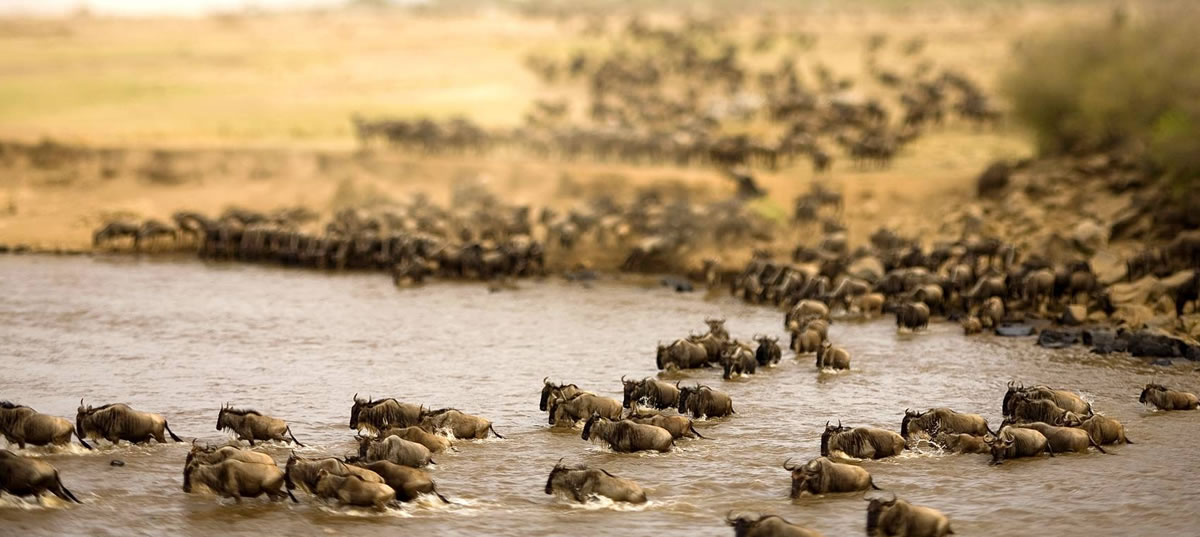Serengeti National Park
North Tanzania Itineraries


- ALFREDO (Italy)
- +39 393 721 9767
- alfredo@primalandsafaris.com
- JACKSON (Tanzania)
- +255 764 800 619
- jackson@primalandsafaris.com
A representation of the all-out, eternal struggle between life and death, the Serengeti is the setting for a mass exodus which takes place every year. With its 14,763 sq km (5,700 sq mi), it is the largest park in Tanzania and hosts "the greatest show on earth".
Being the oldest park in Tanzania, this remote corner of Africa so close to the equator, designated by UNESCO "World Heritage Site" and "International Biosphere Reserve", has inspired a great number of wildlife documentaries because it hosts the most impressive mass migration of the animal kingdom in the entire world.
Lo spettacolo della Grande Migrazione
About 1,600,000 wilderbeests, together with hundreds of thousands of ungulates such as zebras, impalas, gazelles and other herbivores make an exodus of biblical proportions of more than 2 million animals that go round a yearly circular pattern, attracting tourists from the whole planet.
What is the reason for this exceptional mass migration?
There are several factors that result in this earth-shattering phenomenon, most probably on top of the list is the abundance of water and food, particularly fresh grass in a nutritious soil (rich in phosphorus), essential for the female wilderbeests during the feeding period.
Every year, the migration begins in the southern parts of the Serengeti, the Ngorongoro area. Generally, this takes place between April and June, at the end of the wet season, with rains occurring with the astonishing precision typical of the equatorial latitudes.
The herds need water and fresh grass every day, so they stay in a given place as long as there's plenty of them. As the dry season approaches, the grass of the plains starts drying out and the water springs run dry, too. The wilderbeests don't wait for the rain to come, they outrun it by following the course of the clouds that generate it. When the rain falls, the dry plains are soon covered in soft grass blades, an irresistible call for the animals which, in this way, can detect its presence even from great distances.
In these months, the wilderbeests leave the Serengeti plains that have dried out and head north, towards the green grazing lands of the Masai Mara, in Kenya. They set off on an adventurous but dangerous journey.
Mass migration is a well-established anti-predator technique: by moving in herds, the animals minimize the chances of ending up in the jaws of lions, hyenas, cheetahs and crocodiles and this is also why they all give birth to their offspring in the same period of the year. It is easily understood why wilderbeests never move alone, but together with 200,000 other zebras and 400,000 gazelles and impalas.
Some studies have shown how these ungulates can perceive the warning calls from other animal species and use them to run for cover. Along the way, the hardest and most dangerous part is the crossing of the rivers Grumeti, in late spring, and Mara, between August and September. Needless to say, both crossings are bound to turn to carnage. Many beasts are carried away by the raging rivers, at their full at that time, or end up in the jaws of the crocodiles infesting those waters, which lie in wait for such a great chance to stock up on flesh.
The reptiles can detect the vibrations from millions of hooves stamping on the ground well before the ungulates get to the river. Before the crossing, the herds gather along the river banks and the packleaders go on ahead, venturing into the uproarious stream.
Once out of the water, the dangers are not over: lions, hyenas, cheetahs and other predators lie in ambush.
A journey full of dangers that repeats itself over and over again
Between September and October, after travelling for 3,000 Kms (approx. 1,865 miles), lined up in a column of even 40 kms (25 miles), most of the animals gather along the Masa before setting off again, in November, when the grass is once again dry, this time headed southwards, looking for grazing lands after the short autumn rains. Finally, between December and March, the packs are once again on the immense plains of southern Serengeti, where the females give birth to almost half a million newborn animals, then:
Ready, set, go!! And history repeats itself…
PRIMALAND SAFARIS
Tour operator for trips and Safaris in Tanzania and Zanzibar.
Certified Tour Operator in Tanzania
